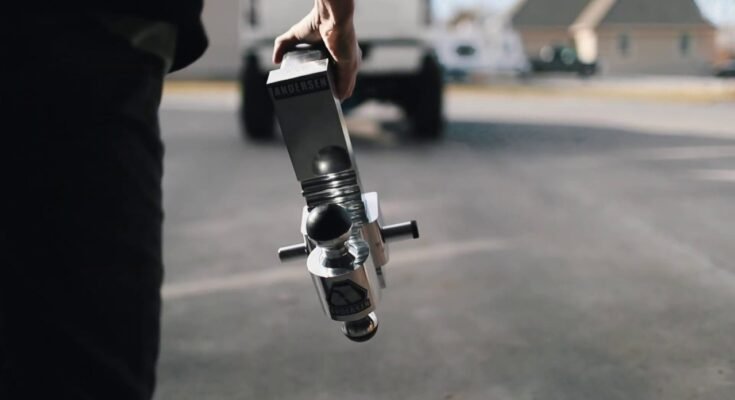Towing involves having the proper tools to help keep you, your trailer, and your cargo safe and stable. Choosing a proper pair of durable trailer balls and mounts is very important for your vehicle and trailer to fit properly.
Installing a Drop Hitch Made Quick and Easy
A drop hitch is usually easy to install and complete within a short time. You only need to pull the pin, move the mount to the required level, and then insert the pin again.
This sophisticated system supports various towing needs, such as light-duty trucks and lifted SUVs, and gives the trailer a level position that is vital for safe towing. Multiple trailers are easy to use because they can both be attached to the same hitch. Flipping the ball allows a fast switch between drop and rise positions, getting you back on the road with minimal delay.
A Reliable Choice for 5th Wheel Towing
Picking the best attachment method for your 5th wheel can greatly influence how simple and smooth your ride is. This Ultimate 5th Wheel Connection has a lightweight design, is quick to install, and offers good stability when the road is uneven.
It comes with a greaseless coupler that is supported by a ball, so it can move more smoothly and create less mess than older versions. The design is convenient and also helps make tighter turns with the steering wheel. It connects easily to both short and long-bed trucks, and it’s preferred by those seeking a manageable way to tow without giving up on power.
Selecting the Right Trailer Hitch Is Important
When choosing a trailer hitch, safety, optimum performance, and integrity of your vehicle are just as important as compatibility. Putting a mismatched hitch on your trailer may result in unsteady movement, imbalanced braking, or severe, dangerous unhooking. Pick towing ball solutions that match your vehicle’s towing capacity and the weight of the load.
Hitch classes range from I to V:
- Class I–II: Trailers for light use and with small loads.
- Class III: Great for accommodating mid-sized campers or boats.
- Class IV–V: Built for heavy-duty loads and larger equipment.
Be Familiar with the Hitch Components
If you have to haul a variety of trailers, using a combo ball hitch is an excellent choice. These make it possible to switch the balls quickly without having to replace the entire mount, which saves effort and eliminates the risk of using different gear.
- Receiver: Attaches to your vehicle and supports the mount.
- Ball Mount: It is connected to the trailer, adjusts height, and provides stability.
- Coupler: Secures to the hitch ball and keeps the trailer attached.
- Safety Chains: Act as a backup in case the primary connection fails.
- Wiring Harness: It gives power to the trailer’s lights, signals, and brakes.
Understanding the need for durable hitch balls
Quality towing ball solutions use materials like stainless steel or chrome-plated steel to resist rust and stand up to the elements. A solid combo hitch, such as the greaseless 1-7/8″ x 2″ alumiball, eliminates the need for lubrication and adds convenience.
These rust-resistant options often come with lifetime warranties on key components, which is helpful if you tow regularly or work in tough conditions. Even the most dependable and tough trailer balls have a certain lifespan. Switch out yours at the first sign of trouble to stay safe and avoid costly issues later down the line.
Selecting a Hitch Ball That Meets Trailer Requirements
It is very important to use the right ball size when towing. Trailers mostly have 1-7/8”, 2” or 2-5/16” balls, designed for different hauling capacities. Ensure that the trailer coupler fits your tow vehicle properly before going on the road.
Stainless steel or zinc-coated options hold up against salt, moisture, and dirt. Having reliable gear ensures your trailer stays steady and secure, whether you’re heading into the mountains or pulling out of a muddy job site.
A good combo ball hitch includes multiple ball sizes on a single mount, making it easy to tow different trailers without swapping hardware. This setup is ideal for anyone managing multiple trailers and saves valuable storage space in your vehicle.
Prioritize safety before every trip, and don’t skip routine maintenance
Before every tow, take a few minutes to double-check your gear. Make sure the trailer hitch balls are the correct size, the coupler is locked down, and the safety chains are properly crossed and secured.
Also, inspect for any signs of wear, like rust, cracks, or loose bolts, and avoid breakdowns. Even the most durable trailer balls can wear down over time, so if something looks off, it’s better to replace it before it becomes a problem on the road.
After each use, check your combo ball hitch for dirt, rust, or damage. Grease moving parts unless you’re using a greaseless model.
Final Thoughts
Whether you’re pulling a camper, boat, or work trailer, using the right hitch gear ensures a smoother towing experience and helps you avoid problems on the road. From trailer hitch balls that resist wear to adjustable mounts that level any trailer, your choices impact every trip. For quality products built to last and designed for easy towing, trust Andersen Hitches.




